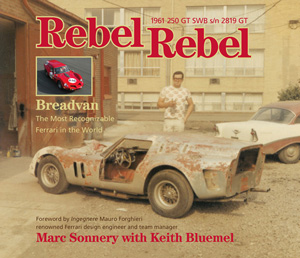
Hardback, 160 pages, color and b&w photos
$80 USD, plus $20 Shipping
By Marc Sonnery and Keith Bluemel
Parker House, 2010
Order here
Review by Pete Vack
The cover: A tall young man in horn-rimmed glasses has a beer while taking a break. He must be tall, for the coupe he is working on appears to be about groin high. Behind this doorless, bare-aluminum Ferrari is a 1956 Chevy and what appears to be an apartment complex. The photo looks to have been taken in the 1960s.
The faded, poorly-focused color snapshot stimulates synapses: This is either something I’ve done or something I have dreamed of doing. Or both.
It is instantly suggestive–or demonstrative– of an era when a bright and eager young man could finagle his way into a rare Ferrari and hope to fix it up himself. It was when cars were cheap, enthusiasm boundless, and nothing was impossible. The cover shot immediately draws me into the story; I am derailed and don’t even notice the off-putting title. I begin to look between the pages for photo credit and identification. Who is this, where is this, and what is going on here? And who has got the unmitigated nerve to put such an old, lousy photo on the cover of an expensive book about a famous, one-of-a-kind Ferrari?
I love it already.
Though it might not be clear from the title “Rebel Rebel,” the car is the famous Ferrari “Breadvan”, born of an argument with Enzo Ferrari, created by the alienated engineer who was responsible for the GTO, and a car which could and did wipe the smile off Enzo’s face with a Snap of the exhaust.
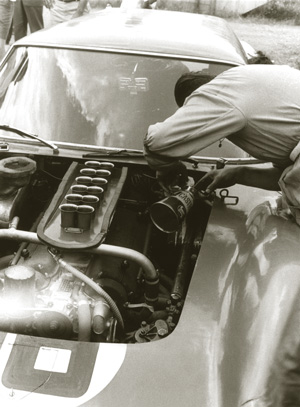
In the 1962 Le Mans paddock during practice or on race morning, s/n 2819 GT, now re-bodied as the Breadvan, is getting some oil. The book offers many such period photos.
Although probably not unique, this book is the only hardbound-full sized volume I have on my shelves that is devoted to only one serial number (2819 GT). A dangerous thing to attempt, and can only work when the subject is rich in anecdote, ownership and history, and the publisher, editor and authors are all on their game. And oh, this is good. Very good.
Parker’s Gamble
Tim Parker is no one’s fool when it comes to publishing automotive books. He’s been around the publishing business for ages, and worked for MBI when MBI was really on top of the car book publishing business. (Disclaimer here–Parker urged MBI to publish this author’s Illustrated Abarth Buyer’s Guide in 1990). This is his first book from his new imprint, Parker House, and it is happily impressive. It helps that he took a personal interest in the subject–Parker first having seen the Breadvan work out at Brands Hatch in 1962 and followed the car’s career with interest.
Using a faded snapshot as the cover image was his idea and he insisted upon its use instead of a traditional, classy photo of the car as it is today or the car on the track at Le Mans in 1962, when for a brief and shining moment the Breadvan did exactly what it was designed to do. In my opinion, Parker’s gamble here paid off. It works and almost wildly so. Still, God knows what they are saying in Ferrari circles.
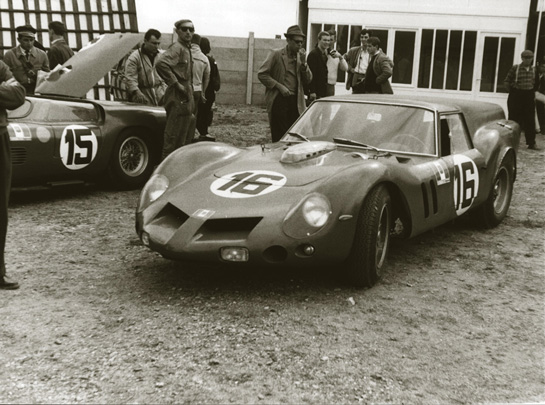
The first public appearance of the Breadvan was on this occasion where it awaits le pesage, as they say at Le Mans. Scrutineering as they say in England, tech inspection as they say in the US. It had to go through twice. One of the several grievances of les commissaries techniques being that the paint was too thin. It does appear that it has been hastily given a second coat—so is this the second attempt? The fact that s/n 0792 is next to it could mean that it is in fact the first attempt and that SSS had been told not to even show up at le pesage when les commissaries saw the car being offloaded from the truck.
The title, though, didn’t beat the odds. No doubt a cultural thing, but “Rebel Rebel”, to the American ear, has connotations to the deep south, the Confederacy, Dukes of Hazard and NASCAR or at best James Dean as “Rebel Without a Cause.” Parker, brought up in the UK, thought the Breadvan was a rebel in terms of breaking with Ferrari. I suspect a good number of people looking for a book on Ferraris will be a bit confused, as will good ol’ boys hunt and pecking Google to see what’s there for the word “rebel.” A book about a Ferrari created by an “Eye-Talian” Count will not be what they seek to find.
Sonnery and Bluemel
“Rebel Rebel” is the work of long time Cavallino contributors Marc Sonnery and Keith Bluemel. Both are good writers and know their subject matter. Bluemel provided a straightforward history of the car right up front. Sonnery however did the majority of the work, conducting interviews with most of the twenty two people–including Count Volpi, Giotto Bizzarrini, Giorgio Neri and almost every owner. The book consists primarily of interview questions and answers. They are almost raw, and in that honesty is not only insight but entertainment. It’s unlikely that Sonnery would have been able to relate experiences with Sonny Bono and the Breadvan as succulently as first person Gary Wales does in the chapter about the ‘Van in Hollywood. Sonnery wisely let Wales wail, and a good lament it is, too.
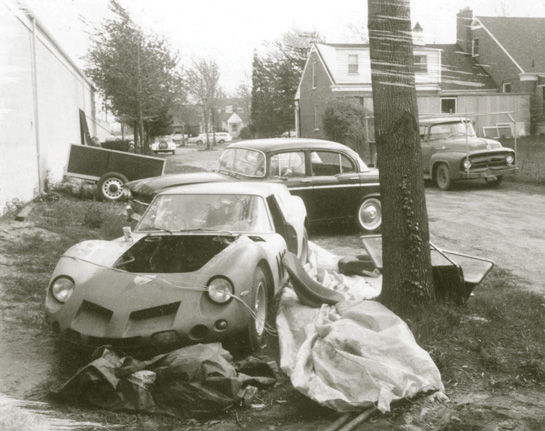
The Breadvan when owned by Gary Wales, slightly earlier in the process when compared to the cover photo, engine out. Note two types of seat on the ground: the racing bucket and the street car passenger seat. Wales did eventually succeed in restoring the Ferrari, was well as driving it from coast to coast.
Interviews also reveal contradictions, mysteries, lapses in memory, no memory at all, interesting remarks about other owners. German playboy Gunter Sachs, via his autobiography quoted by Sonnery/Bluemel, tells the story of being arrested with the Breadvan while on a date with Princess Soraya of Iran, while Count Volpi recalls that it was not Soraya at all. And whatever happened to the original engine block couldn’t be determined by anyone of the participants!
Others are just getting too old too remember. Sadly, Colin Davis, the son of Bentley boy and journalist “Sammy” Davis and primary driver of the car at Le Mans and elsewhere, when contacted, couldn’t recall too much. “I’m sorry, but I don’t remember more. It was an awful long time ago.” Co-driver Carlo Abate had a terrific accident at Le Mans in 1963 that resulted in a memory loss and according to Sonnery, “…a general lack of desire to speak of that era.” Dan Gurney, who drove for Count Volpi’s Scuderia Serenissima, but never the Breadvan, found it hard to remember details. His wife Evi, via VeloceToday contributor Michael T. Lynch, said that we should bear in mind that Dan …“drove in 312 races, supervised another 300, and flew in and out of events.”
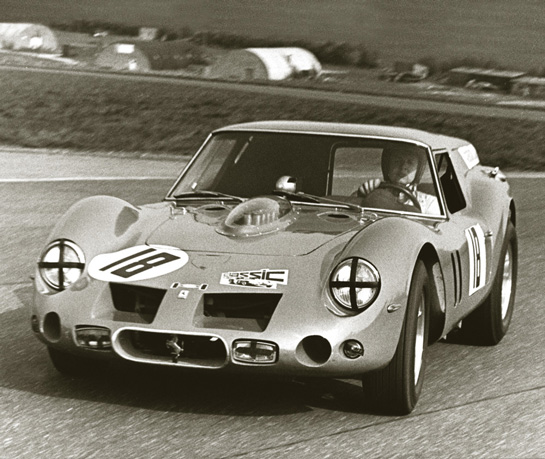
Concentrating hard, John Harper going through the chicane at Thruxton. Matt Ettinger had damaged the nose shortly before selling it into England; this is its initial appearance in the UK, with a chrome surround to the “mouth” complete with prancing horse. It would soon be rudely and comprehensively rearranged!
But the others talked, remembered, loved it and kept track of their adventures with the ’Van. Among the most outspoken was again Gary Wales, who was the eager young man on the cover, (actually hating himself for thinking that beneath the thin paint was a smooth aluminum finish ready for paint). Wales bought the car from Volpi for $3000 dollars. He drove it from New York to Chicago, then from there to Los Angeles, probably accumulating more miles on the car than anyone else. His interview is hilarious, probably true and in many ways, tells the story of the car better than anyone else. EXCEPT
Count Volpi di Misurata himself
While all the interviews and insights are interesting, it was Sonnery’s in-depth talks with Count Volpi in 2000 and 2008 that really make the book. Volpi comes across as intelligent, willing to answer any questions, and still had a remarkable memory. He sets the record straight once and for all about who really built and designed the bodywork, what was the inspiration, and recalls the problems and excitement leading up to Le Mans, when completion of car was rushed in order to compete with the all-conquering GTOs. In a later, second interview, Volpi talks about the palace revolt, the ill fated ATS, (“I never even sat in one”) and his own Scuderia SSS (the triple Ss were perplexing to race-goers.) He also details the painful accident that virtually ended Carlo Abate’s race driving career a year later.

After its February 2006 acquisition by Klaus Werner and the ensuing full restoration to include (at long last) a perfect recreation of the original 1962 nose, the Breadvan was seen at a number of European vintage races. Here at Monza Klaus’ fast son, Max Werner, turning into the variante Ascari with a 312PB in hot pursuit.
Complimenting Sonnery’s interview is a letter written by Volpi to Ferrari enthusiast Gary Barnhill which appeared on Ferrari Chat. Volpi scolds today’s collectors and challenges them to use the millions of dollars more wisely, to help other people rather than buy cars that they can’t really own (just care for). But of course without the collectors, we’d never be able to see these cars in action, much less drive them (as did Sonnery in this case) and live to tell about it.
As the Breadvan got older, for better or worse with each iteration it appeared more groomed, less like itself and more like what others wanted it to be. It began life as rude and crude, unfinished and rather nasty; today it would do well at Pebble Beach. Most remarkably, however, most of the owners on both sides of the Atlantic did not want it to become a “Pebble Beach paint bucket.” choosing to vintage race it at every given opportunity.
Deficits
Price. $80 for 160 pages on one chassis number is a bit steep. Non-chapter addendums such as the preface and index are titled in Italian, Cavallino like, for no apparent reason. Would like to have seen photo credits with captions. Tech details are sparse. No detailed comparisons to equivalent GTOs (the addition of which may have made a larger, more comprehensive book). But these are minor gripes. The book is well, done, informative and truly entertaining.
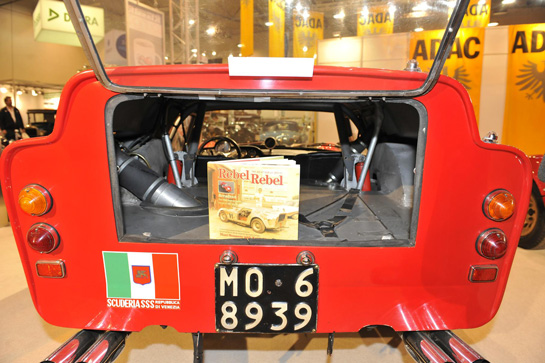
The little truck delivers goods. Seeing both the car and the book together at Essen this year was very special for Marc Sonnery. Photo by Dirk de Jager.
“Rebel Rebel” is as different and enjoyable as the car it so aptly defines, and will need a new slot on our bookshelf: books on cars by serial number. Highly recommended.
Watch an interview with the author:

It will sit on that shelf next to “Maserati 3011: The Story of a Racing Car”
by Denis Jenkinson
Great review. Weird thing is, I know I’ve seen this car, but can’t remember where. One small edit: “…….be determined by anyone one of the participants! “. Should be “any one of the participants” me thinks. This is at the end of the first paragraph under “Sonnery and Bluemel”. Thanks for the good read.
Steve
This car sat outside an off brand gas station along El Camino in San Mateo, CA. for weeks in the mid to late sixties. We would pass the thing while cruising the EC in our 55 or 59 Chevys. I can remember spending time going over the car and my amazement when we discovered it was a Ferrari. Ratty seems to fit the memories I have of the cars condition. Someplace in an old file envelope are b/w negs of the car. Boy wish I could shake up the memory cells to come up with a firm year/date.
Well done Mark & Keith. The book we thought should be published is finally done! I hope that the book reveals some new stories about the old girl! BTW, when the car was done in Italy in 1987 we only had one coat of paint put on to keep the weight down – I wanted the car to be what it was designed to be – the fastest of the GTO’s. And Denis, your title is apt for the Breadvan as well – the story of a racing car. This one never stopped being driven hard and, thanks to Klaus and Max, is still being raced successfully. I can’t wait to read your work, thanks, and congratulations!
Monte:
Coming from yout he comment is very much appreciated: thanks for your welcoming help a decade ago, I will never forget that wonderful weekend in Napoleonville at Madewood plantation!
best regards to you and Merritt,
Marc
For those of a certain age, Rebel Rebel could mean something else…
David Bowie, 1974
“Rebel Rebel, you’ve torn your dress
Rebel Rebel, your face is a mess
Rebel Rebel, how could they know?
Hot tramp, I love you so!”
good read and good review
I remember that car when Gary Wales and Dick Merritt brought it back from New York. I had many rides in that car- it drove like a Chevy six below 4000 rpm button like an electric motor up to red line.
Chris Cooper